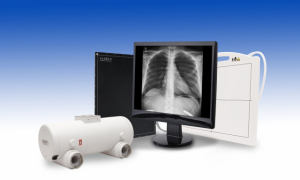by
Diana Bradley, Staff Writer | February 27, 2012

Varian Medical Systems'
Paxscan components for DR
From the January/February 2012 issue of HealthCare Business News magazine
Birthed in the late '90s, digital flat panel detector technology provides a digital readout of an X-ray image. There are two types of flat panel technology: direct panel - which converts X-rays into electrical current; and indirect panel - which, in a two-step process, converts X-rays into light, then shifts into an electronic signal. But recent trends have shown the general radiography industry moving away from direct panels, according to Dr. David Waldman, chair of imaging sciences at the University of Rochester, N.Y.
"With direct panels, which use selenium material, there is a latency time that you have to charge the plate," he says. "It's hard to take multiple images with this technology."
The most common X-ray detection material for indirect conversion detectors is cesium iodine or gadolinium crystal. Cesium iodide has very high detective quantum efficiency for high image quality at low dose, is fluoroscopy capable and advanced application capable. While selenium is currently not capable of fluoroscopy, it has low X-ray absorption and high sensitivity to temperature. According to Waldman, who uses Carestream Health, Inc.'s cesium panels at his medical center, cesium iodine is the faster, more efficient option, and its high price reflects this.
Major players in the market include GE Healthcare for indirect flat panel technology; and Siemens Healthcare and Fujifilm Medical Systems USA, Inc. for direct flat panel technology, according to Andrew Smith, Bedford, Mass.-based Hologic, Inc.'s vice president of imaging science.
Indirect and direct flat panel detectors have advantages and disadvantages, depending on the application. For some applications, high resolution is important. For others, high dose efficiency is important. And sometimes, you need both high dose efficiency and high resolution.
"The advantage of direct conversion is very high intrinsic resolution, but at the cost of larger noise at high spatial frequencies," says Richard Colbeth, vice president of engineering at Palo Alto, Calif.-based company Varian Medical Systems Imaging Products, who manufacture amorphous silicon flat panel detectors with cesium and gadolinium scintillators. "Coupled with the higher X-ray sensitivity cesium, the result is that indirect conversion has better DQE — a measure of contrast resolution — over all spatial frequencies. DQE is considered the most important measure of image quality and cesium panels have the best DQE."
Also accounting for the decrease in direct panel demand is its short life expectancy. Selenium can be destroyed at temperatures below 5 degrees Celsius and above 45 degrees Celsius, so it requires special shipping and handling procedures, according to Colbeth. In addition, selenium panels require between 2,000 and 10,000 volts applied to the selenium layer, which can contribute to early panel failure from arcing. Meanwhile, Waldman says his cesium panels are over five years old and have never failed.
